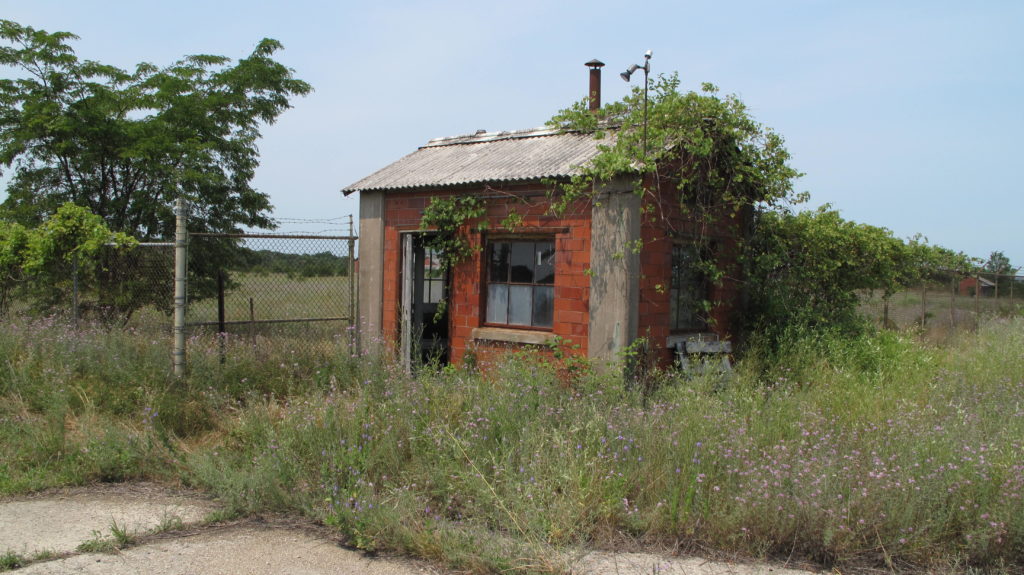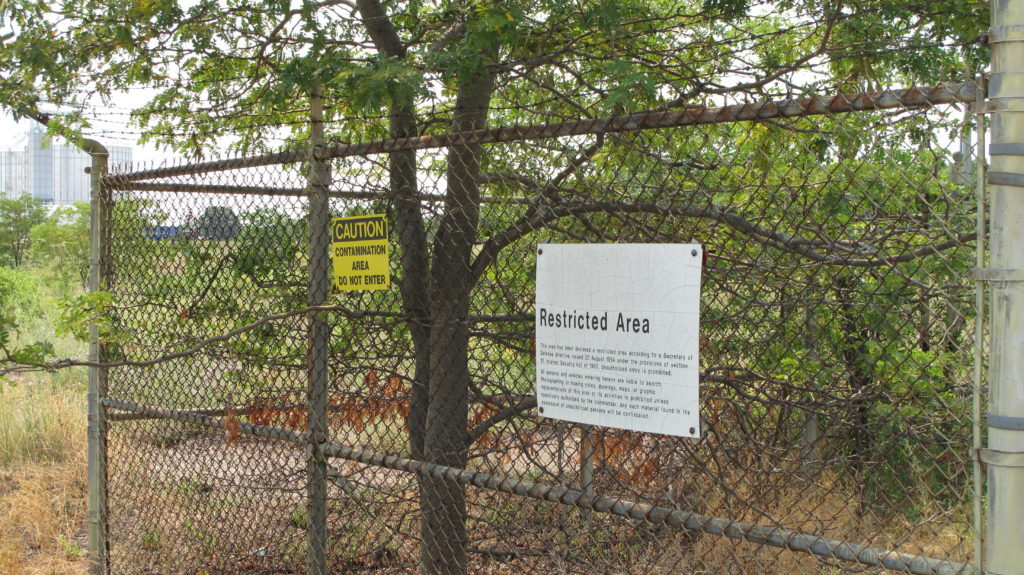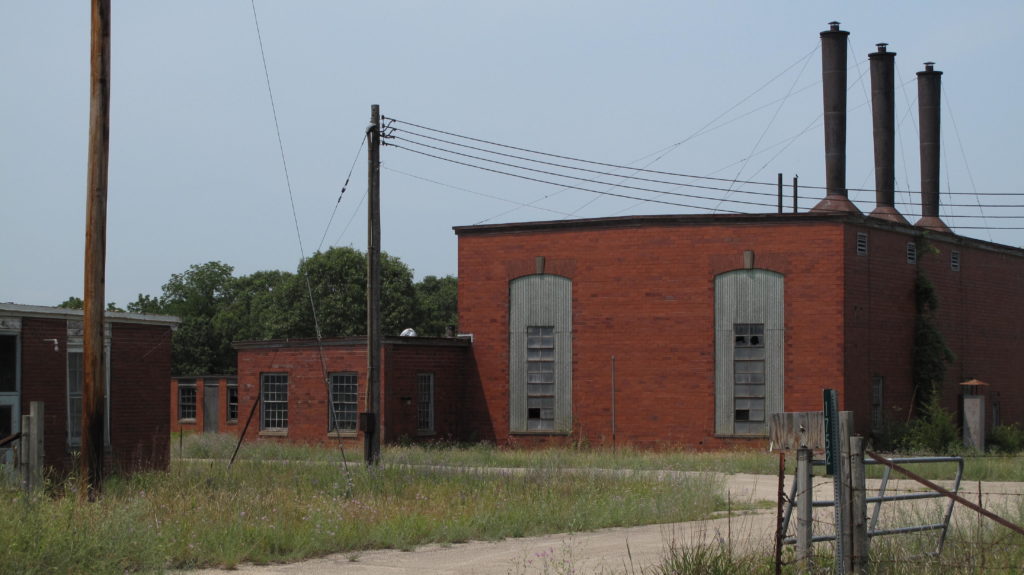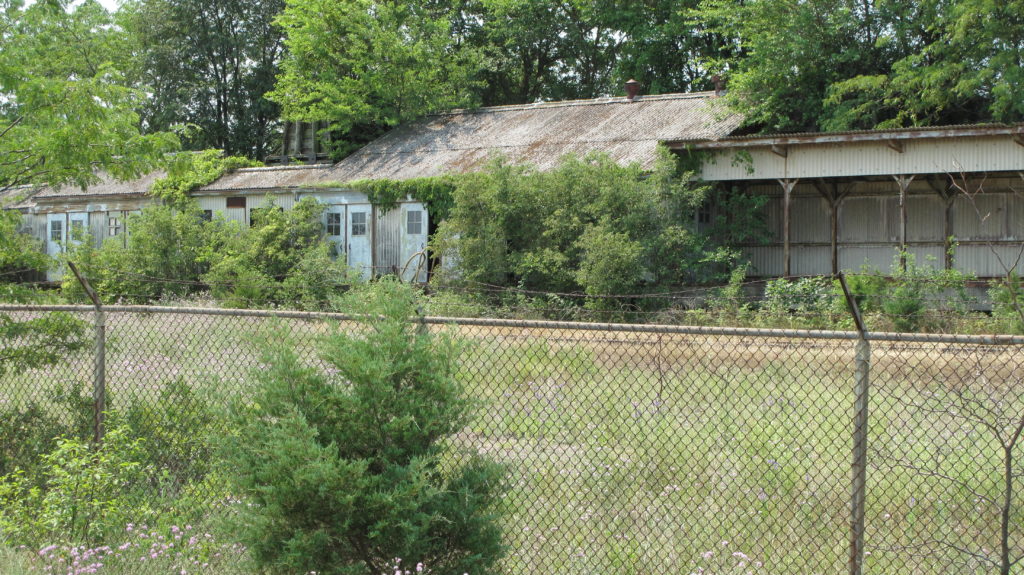“Well, We’re Still Waiting…”: The Prolonged Crisis of Military Facility Closures
By: Alison Kanosky
Once the last remaining bombs had been removed from the Savanna Army Depot, things got quiet around Savanna, a small town in rural northwest Illinois. Since 1918, area residents employed as civilian workers kept the Depot bustling. They manufactured munitions at the facility, maintained and stockpiled ordnance en masse, and tested bombs by burying and detonating them out in the prairie overlooking the Mississippi River. Rob Wheeler recalled that when he worked in explosives maintenance at the Depot in the 1990s, “we destroyed ammo that was found not to be effective anymore.” Rob explained, “we would take it out to the demo ground and set charges and make it go away. One 3-week period we burned over a million pounds of defective propellent.” Of course, the ammunition might have been destroyed, but it did not fully “go away.”
Decades after the Army closed the facility in 2000, the lingering impact from its past use haunts this place in the soil and groundwater. Upon its closure, the Environmental Protection Agency declared the Savanna Army Depot a Superfund site, given the enduring contamination from TNT, asbestos, unexploded ordnance, chemical pollutants, and the residues of other environmental hazards. The Department of Defense is responsible for funding the restoration of former military lands to communities in a usable state, but the cleanup has been glacial at many sites like the Savanna Army Depot.[i] In the years—decades—since, residents of Savanna have experienced the facility’s closure and its subsequent neglect as a long crisis of abandonment.
The experiences of those living near the Savanna Army Depot are shared by many communities near decommissioned facilities, where the enduring abandonment “has had such prevalence that it is no longer a critical event but instead a critical continuity—a condition, rather than an aberration” (Vigh, 2011: 95). This crisis of abandonment offers a unique opportunity to examine how state power is reproduced in a dramatically changing domestic military landscape. Many scholars have considered the operation of military facilities as exercises in state power and imperialism (See for instance, Enloe 2000, Gill 2004, Gusterson 1996, Lutz 2001, MacLeish 2013, Masco 2006, Vine 2015). The shuttering of military facilities can open opportunities for resistance as residents seize upon new political, economic, and environmental possibilities (Durant 2007, Havlick 2018, Lutz 2009, McCaffrey 2002). In this essay, I consider abandonment of military facilities as a different technique by which state power is exercised, and argue that the crisis at the Savanna Army Depot has undermined residents’ own sense of empowerment.
“In almost all former military sites, at least some environmental remediation is required prior to transferring the land. At more contaminated sites, the Department of Defense has continued to retain possession of the land because the extensive remediation occurs at such a slow pace that the land transfer cannot yet been completed.”
Over the course of the 20th century, the U.S. landscape of war production underwent significant change. As the nature of military strategy changed, the focus and footprint of production also shifted. Since 1988, in response to and in furtherance of technological changes, the Department of Defense has closed more than 100 military facilities across the country under the Base Realignment and Closure Commission (BRAC).[ii]
The U.S. Department of Defense follows several procedures for returning land after a military site is closed. In many sites, a majority of the land is transferred to other federal or state agencies for use. In some instances, former military lands may be converted to wildlife refuges, which require a less stringent level of environmental remediation. This was the case for the Savana Army Depot, where a U.S. Fish and Wildlife Services refuge was established on a large portion of the land. The remaining land is left for local community use. In almost all former military sites, at least some environmental remediation is required prior to transferring the land. At more contaminated sites, the Department of Defense has continued to retain possession of the land because the extensive remediation occurs at such a slow pace that the land transfer cannot yet been completed. Nationwide, the Department of Defense continues to hold 72,683 acres at 50 defunct military facilities that cannot yet be transferred back to local municipalities.[iii] In the most severe cases, including the Savana Army Depot and 33 additional decommissioned military facilities, the lands are still designated as Superfund sites and remain on the EPA’s National Priorities List, despite the fact that they were closed between 18 and 25 years ago.[iv] And so the challenges wrought by military base closure extend beyond the moment of closure itself. In these decommissioned sites, the military is absent but not fully gone, maintaining ownership of the land and a hold on its future use.
In the meantime, residents of nearby communities are left to wait. The experience of waiting itself can provoke a sense of a loss of control, undermining residents’ feelings of agency. Harms (2013) has examined a similar dynamic in his work on urban development and residential displacement in Ho Chi Minh City, theorizing that residents experience “eviction time” in which “temporal uncertainty can work as a form of social control” by upsetting resident’s “attempts to construct livelihoods and build meaningful lives” (352-354). Similarly, when I conducted fieldwork in the area between 2012-2014, residents living near the remnants of the Savanna Army Depot described feeling stuck while dealing with prolonged uncertainty about the future of both the land and their livelihoods.
When she spoke of the Depot’s closure, Rhonda Walker, a former employee, kept stopping herself from calling the event “traumatic.” She felt hesitant to use this word, she told me, because for years, rumors had circulated of an impending closure. Then, following the official BRAC closure announcement in 1995, the shutdown was gradual, with the Army slowly laying off people until the Depot fully closed in 2000. “In what other job are they going to tell you you’ll be laid off in five years?” she pondered with a sense of appreciation, demonstrating a reluctance to be too critical of the military.[v] Like Rhonda, many residents experience of the Depot’s closure was less a catastrophe than the inevitable arrival of a piece of bad news they had been anticipating for years. In this sense, Rhonda and other workers’ predictions of a possible closure can be seen as a strategy of vigilance (Vigh 2011) that led them to prepare for, accept, and even feel gratitude for the terms of the closure.
While residents did not speak about the closure itself as a shock, its aftermath has produced an enduring crisis along environmental and economic fronts. Of course, the crisis of environmental contamination at the Depot did not begin with the Army’s departure, but rather with its arrival. Lands that became defense facilities in the first place were often chosen because they were considered by the military to be “zones of national sacrifice” (Kuletz 1998, 8)—areas that were hospitable for dangerous, contaminative work in the service of “exert[ing] military power globally.” Like the Savanna Army Depot, many former military facilities were used as dumping grounds for hazardous materials for decades, and their rurality and isolation were used to justify their environmental degradation. The military’s devaluation of the land, water, animals, and people near these facilities is similarly reflected in their slow restoration of the decommisioned land.
Upon the closure of the Depot, many residents became aware of and widely acknowledged the extent of the contamination. Yet residents primarily speak about the environmental devastation as a crisis only insofar as it hampers the economic redevelopment of the land. Citing the continued damage caused by pollutants that seep into soil and groundwater, a small number of residents near the Savanna Army Depot advocate for environmental cleanup for its own sake, though they are often socially and culturally ostracized for de-emphasizing economic redevelopment. The economic crisis, then, is centered by most residents as the primary issue to be addressed regarding ongoing military abandonment.
“Entering the Savanna Army Depot today feels like stumbling upon a deserted industrial city that was evacuated overnight, left untouched since the last worker was laid off.”
Residents recalled that in the years that followed the Depot’s closure, people left, businesses closed, and folks tried to pivot to find different kinds of work. The economic and cultural changes were visceral and lasting. Many cited the Army’s departure as a key factor in worsening economic depression in the area. The direct and indirect damage to employment opportunities in the region—particularly the loss of high-paying military jobs—impacted the community deeply.
The economic loss was exacerbated by the cultural loss of identity that residents experienced with the departure of the Army. Some residents expressed that the communities near the Depot had once felt a great sense of national importance, but now felt that they had been discarded by the military. And, they warned, the ongoing military abandonment indicated bleak community prospects for the future. Rhonda described this in her experience of seeing the continued decay:
I think it’s hard when you live here. I mean, obviously, there has to be potential [at the former Depot facility], it was built on the river, you know, the scenery is beautiful… it’s just tough. We go year after year, and there’s just not much progress. You really see that things are falling down around themselves… I keep thinking, God I know there’s gotta be some good stuff here… But my head just isn’t seeing it.
As Rhonda’s discussion shows, she interprets the lack of redevelopment as a reflection of the area’s limited possibilities, making it challenging to imagine alternate future prospects. Other residents added to this discussion of the lack of reinvestment. As area resident Al Wagner told me, “It was troubling to us how the federal government could just leave us high and dry like this” following the Army Depot’s closure. Al’s words echoed Rhonda’s disappointment in the Army’s progress. They both sensed that the military had abandoned the community, which produces an existential crisis on both the community and individual level.
Entering the Savanna Army Depot today feels like stumbling upon a deserted industrial city that was evacuated overnight, left untouched since the last worker was laid off. Hundreds of buildings on the more than 13,000 acres sit rusting, with broken windows, stray wires, padlocked doors, and with trees growing out of holes in the roofs and windows. Stephanie Boyd sees this daily, as she is employed with the local redevelopment authority working to redevelop the former military land. Although Stephanie is employed to reinvigorate the Depot, she described a similar sense of disempowerment:
I think that we could write the same book year after year about dealing with the Army. I mean, every year, it would say, “well, we’re waiting for [the Army to transfer] this deed.” And I think a year later, I could go back and say, “well, we’re still waiting for this deed.” And so it’s very frustrating and it just seems like there’s no hope. And everybody in the communities have lost any hope for anything. But I see there is potential, I see that things are happening, and I believe that things will happen.
While Stephanie’s employment puts her in a position to help ameliorate the economic crisis at the Depot by helping to attract new businesses, even she felt like the military held the community’s future prospects interminably in its hands; until the Army cleans up and returns the land, Stephanie’s work of marketing that land to future tenants feels nearly impossible.
Individual and community responses to crises have the capacity to alter or reinforce existing power relations. Joseph Masco (2017, S73, S66) has examined how crisis has been made into a “permanent condition,” in which certain specters of harm are prioritized while everyday public harms such as environmental contamination are worsened through strategically deployed inaction. The crisis, then is often responded to in a “crisis-paralysis circuit” which does not meaningfully alter or reimagine societal or cultural structures, but rather “stabilizes an institution” and “…restores the conditions from which crisis emerged” (Masco 2017, S73). In the process, solutions to crises function to “maintain the current state of affairs” and “further entrench power” (Whyte 2006, 61), as the public can simultaneously perceive their nation-state to be extremely powerful while also perceiving themselves as a public to be powerless (Masco 2017, S66).
It is understandable that residents sense that they are subject to the whims of the military, but their sense of disempowerment also limits their view of what they are capable of changing or demanding. Many residents focus on restoring economic development rather than advocating for more thorough environmental restoration. In so doing, they have sought to hold the military accountable only for how it has impeded the reinvestment of capital, rather than the underlying conditions that permitted the Depot’s ruination in the first place: the devaluation of their lands, labor, and even of their lives. Focusing on redeveloping the land, then, becomes the primary crisis to be attended to, and environmental remediation becomes minimized by most residents as important only insofar as it is completed to an industrial use standard to transfer the land to the local redevelopment authority.
Twenty-three years later, residents are still waiting for the remaining land to be returned to them, and they continue to live with toxic environmental contamination that awaits remediation.[vi] As they wait to have the Savanna Army Depot land cleaned and returned, residents discussed with me how the community felt pressured by the Army to accept an early transfer of the unremediated land. Such an agreement would allow the community to redevelop the land more quickly, but it also would remove the Department of Defense’s obligation to pay for the land’s cleanup. The community has resisted the pressure to accept an early transfer. Despite the disempowering effect of “temporal uncertainty” and its efficacy as a form of “social control” (Harms 2013, 352) residents show an important measure of resistance by continuing to wait rather than let the Department of Defense abnegate responsibility. Still, despite this resistance, the military has effectively turned the Depot into ruins and kept it in a state of ruination (Stoler 2013), prolonging the community’s economic stagnation and exposure to environmental hazards.
Looking at the abandoned grounds of the former Savanna Army Depot reveals the unyielding power that the military holds: in the process of making certain places into ruins, and in maintaining a state of ruination in those places, the military preserves and gains financial and political power, while directly impeding local control over the future of these now-decommissioned lands. The land remains in a liminal state, owned and controlled by the Army but largely empty. The standstill at this former defense facility reifies state power: even as it conducts remediation at a snail’s pace in decommissioned facilities, the military has only increased its access to funding, land, resources, and technology, while continuing to receive such widespread political and cultural acceptance that even residents whose groundwater has been polluted by the military are hesitant to critique it. In the process of prioritizing the economic crisis, and conceptualizing that crisis as one that will end when the land is finally transferred back to the community and new investments of capital are made, residents forgo opportunities for more critical questioning of the damage the military has caused their community and many others nationwide and worldwide.
Endnotes
[i]RKG Associates, Inc. 2018. “Reuse Plan- Jo Carroll Depot Local Redevelopment Authority.” Savanna Industrial Park website. https://www.savannaindustrialpark.org/pdf/doc-reuse-plan-1555540916.pdf
[ii] There is a different process for closing U.S. military bases outside of the U.S.
[iii]Congressional Research Service. 2019. “Appendix B” in “Base Closure and Realignment (BRAC): Background and Issues for Congress.” https://sgp.fas.org/crs/natsec/R45705.pdf <last accessed April 22, 2023>.
[iv] United States Environmental Protection Agency. “Base Closure at Federal Facilities.” Last updated June 28, 2022. https://www.epa.gov/fedfac/base-closure-federal-facilities <last accessed April 22, 2023>.
[v] All interviewees are referred to using pseudonyms. Interviews for this article were conducted between 2012-2014.
[vi] As of 2018, 64% of the land had yet to be turned over to the community from the Army. RKG Associates, Inc. 2018. “Reuse Plan- Jo Carroll Depot Local Redevelopment Authority.” Savanna Industrial Park website. https://www.savannaindustrialpark.org/pdf/doc-reuse-plan-1555540916.pdf
Alison Kanosky is an Assistant Professor of American Studies at California State University, Fullerton. She holds a Ph.D. in American Studies from Yale University. Her ethnographic research explores the impact of defense and carceral infrastructure on American communities.

Works Cited
Durant, Robert F. 2007. The Greening of the U.S. Military: Environmental Policy, National Security, and Organizational Change. Washington DC: Georgetown University Press.
Enloe, Cynthia. 2000. Maneuvers: The International Politics of Militarizing Women’s Lives. Berkeley, CA: University of California Press.
Gill, Lesley. 2004. The School of the Americas: Military Training and Political Violence in the Americas. Durham: Duke University Press.
Gusterson, Hugh. 1996. Nuclear Rites: A Weapons Laboratory at the End of the Cold War. Berkeley: University of California Press.
Harms, Erik. 2013. “Eviction Time in the New Saigon: Temporalities of Displacement in the Rubble of Development.” Cultural Anthropology 28 (2): 344-368.
Havlick, David G. 2018. Bombs Away: Militarization, Conservation, and Ecological Restoration. Chicago: The University of Chicago Press.
Kuletz, Valerie. 1998. The Tainted Desert: Environmental Ruin in the American West. New York: Routledge.
Lutz, Catherine. 2001. Homefront: A Military City and the American 20th Century. Boston: Beacon Press.
______. 2009. Bases of Empire: The Global Struggle Against U.S. Military Posts. New York: New York University Press.
Masco, Joseph. 2006. The Nuclear Borderlands: The Manhattan Project in Post-Cold War New Mexico. Princeton, NJ: Princeton University Press.
______. 2017. “The Crisis in Crisis,” Current Anthropology 58 (S15): S65-S76.
MacLeish, Kenneth. 2013. Making War at Fort Hood: Life and Uncertainty in a Military Community. Princeton: Princeton University Press.
McCaffrey, Katherine. 2002. Military Power and Popular Protest: The U.S. Navy in Vieques, Puerto Rico. New Brunswick, NJ: Rutgers University Press.
Stoler, Ann, ed. 2013. Imperial Debris: On Ruins and Ruination. Durham, NC: Duke University Press.
Vigh, Henrik. 2011. “Vigilance: On Conflict, Social Invisibility, and Negative Potentiality.” Social Analysis: The International Journal of Anthropology 55 (3): 93-114.
Vine, David. 2015. Base Nation: How U.S. Military Bases Abroad Harm America and the World. New York: Metropolitan Books.
Whyte, Kyle. 2020. “Against Crisis Epistemology.” In Routledge Handbook of Critical Indigenous Studies, 52–64. New York: Routledge.
You may republish this article, either online and/or in print, under the Creative Commons CC BY-ND 4.0 license. We ask that you follow these simple guidelines to comply with the requirements of the license.
In short, you may not make edits beyond minor stylistic changes, and you must credit the author and note that the article was originally published on Home/Field.



